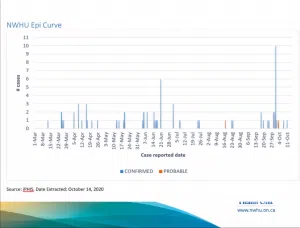
Why is Dryden grouped with Red Lake for reporting COVID-19 cases in the Northwestern Health Unit catchment area?
That’s a question that’s been pondered by many since March and was asked and answered at the Rotary Club of Dryden’s virtual meeting on Wednesday by Medical Officer of Health Dr. Kit Young Hoon.
“We are a large geographical area, with relatively small population numbers. Part of the issue is every time we release a case and we have small numbers, the province also releases information about that case. So you can combine the provinces information with our information and that person could be identified. We’ve had to, therefore divide up our population with a certain population number in mind to prevent it from making it easy to identify someone. So that’s why we ended up with the regions that we did, it’s based a lot on overall population numbers.”
The health unit releases the geographic location, where as the province releases date of test, date reported, age range, gender and if travel was involved.
Young Hoon adds although it would have been nice to keep the two communities separate the decision was based on population numbers, as well as advice from the Information and Privacy Commissioner of Ontario.
“The privacy legislation does allow us to give more detailed information about a case, if we feel its useful to the public. If there was a sudden increase in large numbers in the Dryden area that made it different from the rest of the catchment area where we required people to have heighted awareness, then we would release that publicly.”
Young Hoon pointed out the 10 cases identified in Kenora as an example when they specified location out of concern for public health, rather than saying the Kenora area, which includes a number of communities together.
Meanwhile Our COVID-19 situation remains far different in Northwestern Ontario compared to the rest of the province.
Young Hoon says one of the big differences is our testing rates.
“A huge proportion of our testing has been applied to long term care homes, health care providers and visitors to long term care homes. So a lot of this testing numbers refer to people who got tested three, four, five times.”
Since March, there’s been 33 thousand tests done in Northwestern Health Unit catchment area with 70 positive COVID-19 test results.
However, Young Hoon explains why testing only goes so far.
‘With all infectious disease data, (testing) it’s just the tip of the ice berg, because there may be cases happening in a community that we won’t be able to detect or pick up because people aren’t coming forward for testing. So that’s why it’s really important to look at trends, rather than the actual number.”
One of those trends includes the rate of testing positive which sits at 3.6 percent in the province, versus 1 percent a few weeks ago.
That’s why the health unit continues to recommends preventative measures such as physical distancing, hand washing and wearing a mask, while stressing everyone should assume COVID-19 is in their community.

A closer look at COVID-19 trends in the NWHU catchment area.



